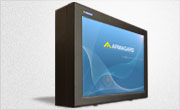Interactivity – The Next Step In Outdoor Digital Signage
Posted by: Richard Williams | Posted on: | 0 Comments
Over the last decade, digital signage has become one of the fastest growing forms of media. Screens promoting and advertising products and brands adorn so many areas, from airports and shopping malls to along the high street.
Indeed, outdoor digital signage, while still nowhere near as prevalent as indoor screens, is growing rapidly, with nearly 15 percent of all outdoor adverts now digital.
Outdoor digital signage has both advantages and disadvantages compared to indoor screens. The audience that an outdoor screen can reach is far larger than most indoor screens, with passersby, commuters and those travelling passed in vehicles all able to see outdoor signs. On the downside, dwell times for outdoor digital signage are much lower; audiences may spend up to eight seconds on the average indoor screen, while outdoor digital signage can only expect half that time—even less in poor weather.
Because of this short dwell time, eye-catching and engaging content is even more important for an outdoor digital sign, but giving people a reason to interact with the display is even more effective in getting a promotion or brand remembered.
Touch Screen
Using touch screen technology for outdoor digital signage is one way of providing interactivity. Providing consumers with something they want, whether its information or even entertainment is a good method of instilling brand remembrance.
Several brands have employed touch screen games at areas with a captive audience, such as bus stops, providing the audience, who have with little else to do, with a form of entertainment, allowing brand recognition while they play.
QR Codes
Another method of offering an audience something they may want is by employing QR codes (quick response codes). These barcode like symbols, readable by modern phones can provide an audience with money-off coupons, prizes, additional information, website details, and even, as used by one supermarket chain, allows consumers to order shopping while waiting for a train or bus.
Post shortlink:
Popular Products
LCD Enclosure
Need armor for your LCD/LED screen(s)? Outdoors or inside the versatile LCD enclosure protects against thieves, vandals & the weather. Installation idea: NFL stadiums.
Outdoor Digital Signage
Exclusive 46” outdoor screen protection. Dubbed the ‘Totem’, due to its distinct design, it repels damage threats, but attracts audiences. Installation idea: Drive-thru restaurants.
Portrait Flat Panel Enclosure
Safeguard your eye-level advertising display screen(s), indoors or outdoors. Completely customizable, add exciting features like touch screen technology. Installation idea: Restaurant frontages.
Indoor Digital Signage
Popular purchase for retail outlets! Great for ‘point of sale’ persuasion, boost your brand with static & motion advertising from a single unit! Installation idea: Mall of America.





